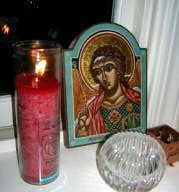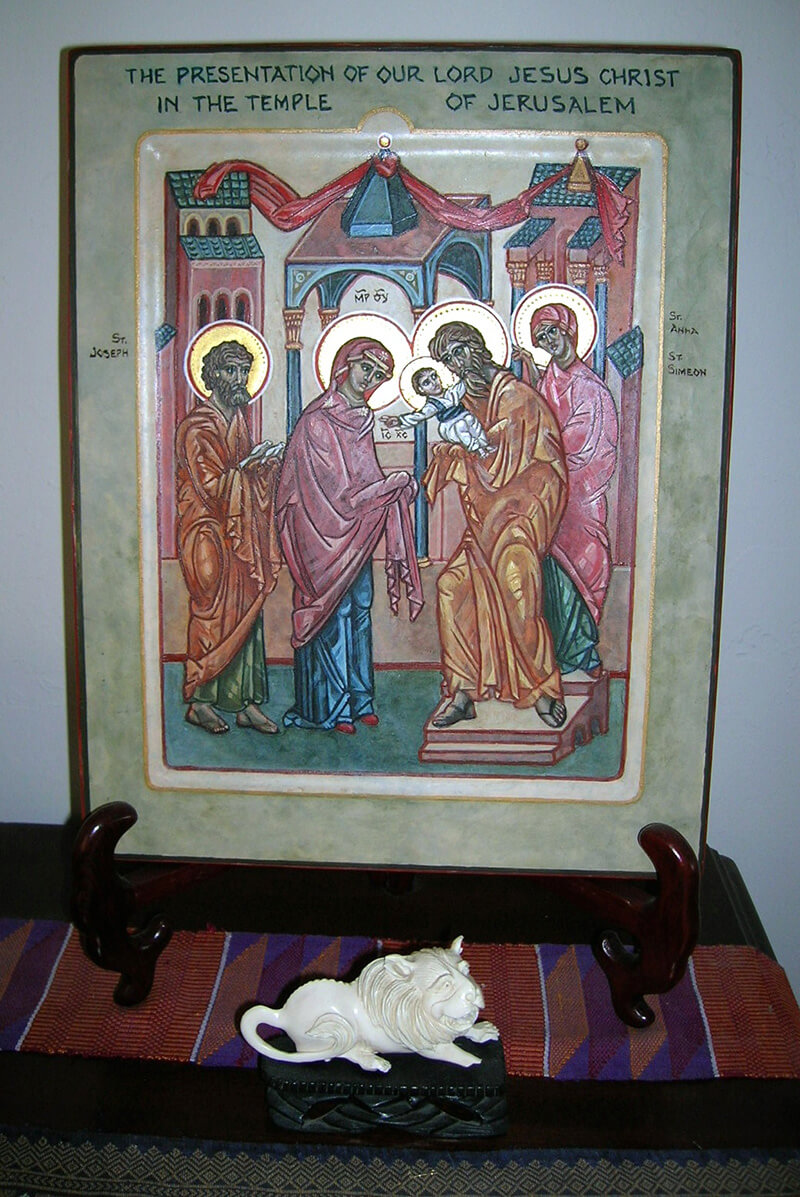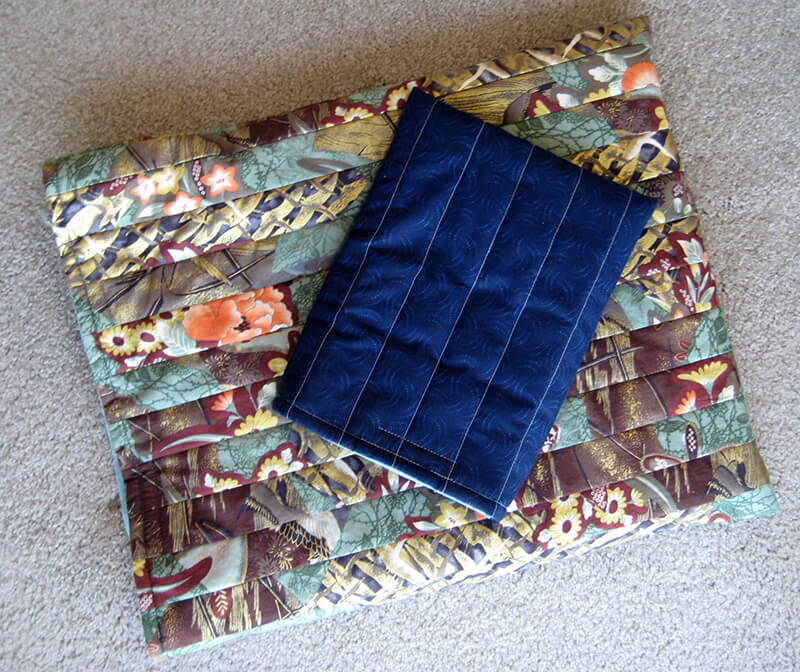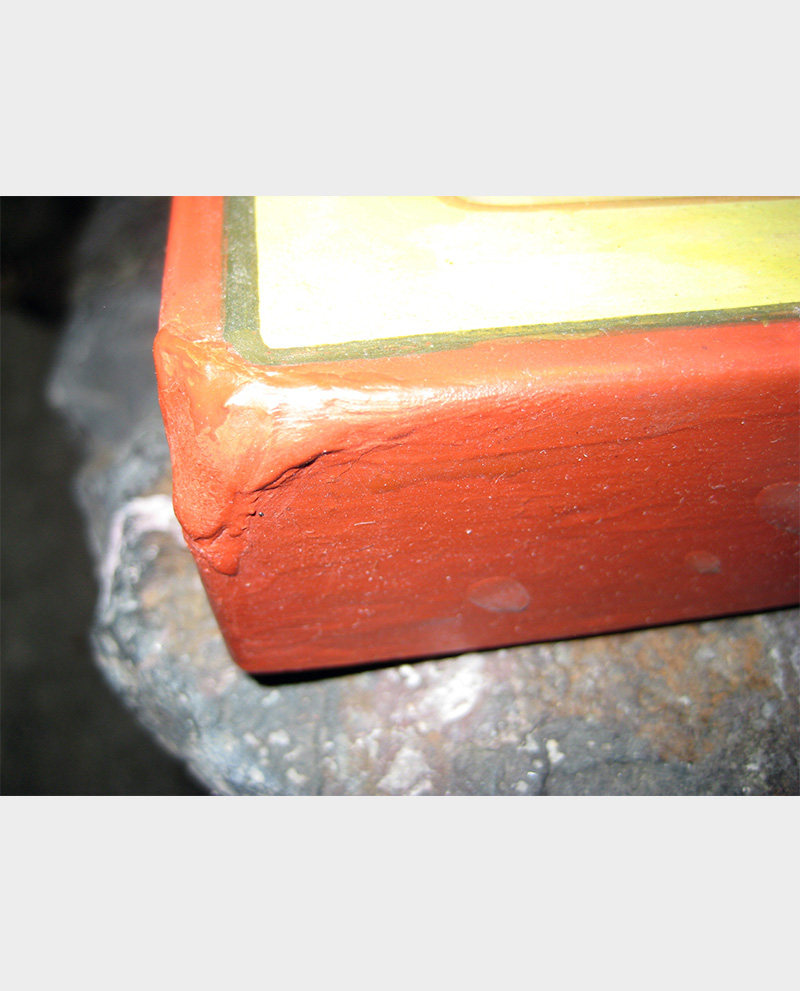DISPLAYING A BYZANTINE ICON
Icons are more than art; they are "windows into heaven" which facilitate an eye-to-eye and heart-to-heart relationship with the holy person depicted.
A portable icon is best displayed on a stand at eye or counter level, where it can be touched or kissed. This traditional art form comes from a time before picture frames and picture hooks.
When presenting an icon as a gift, include a table easel or plate stand for display, and explain that the icon is not intended to be hung on the wall.
At Church
At St. Gregory of Nyssa Episcopal Church, San Francisco, CA
At Home
I enjoy displaying my icons on tabletops and bookshelves around my home - many small altars!
Flowers, candles, and beloved small objects are appropriate accompaniments. As always, take precautions with lighted candles.
In Orthodox homes, icons are traditionally displayed on a special wall-mounted shelf, often with a hanging lantern. These shelves and lanterns are available from www.Pandora-store.com and Orthodox religious supply houses.
A Group Exhibition At Saint Gregory's Church, Spring 2005
For this exhibition, we made wooden ledges, painted the same gray-green as the wall, on which to set the icons. The icons were also affixed to the wall with a spot of "museum clay" in each corner. The inconspicuous labels were printed on clear "stickybak."
Many of these icons are shown at larger scale on the Artist Friends page.
For displays of framed prints, see the Exhibitions and Publications page.
A NOTE ON PHOTOGRAPHY - As you can see from the photo above, a flash can cause problems!
Photograph icons outdoors on an overcast day or in light shade, for diffuse natural light with minimal reflections. The natural light also provides better color accuracy than studio light.
You may find it difficult to position the camera square with the icon, so that the edges appear parallel and the corners appear at 90 degrees. Photographer Richard Anderson tells me he solves this problem by setting the icon flat and mounting his camera on a tripod above the icon. He places a small bubble level from the hardware store on the icon, places another bubble level on the camera, and adjusts both icon and camera until the bubbles in both levels are in the same position. Then the camera should align square with the icon.
If practicable, photograph the icon before applying olifa! Then the surface will be less reflective and less likely to show "hot spots" when photographed.
Quilted Cotton Storage Envelopes For Icons
Storage envelopes shown were hand crafted by Judith Tucker, an iconographer and quilter, www.jtuckericons.com, and are available from her for $15.00 to $40.00 and up (depending on size), plus shipping. Contact Judith Tucker here.
These sturdy and beautiful envelopes have Velcro closures. Color and pattern will vary.
If you like to sew, you can make your own protective storage bags or envelopes.
How To Care For Your Icon
STORAGE: Icons may be stored either horizontally or vertically; but the painted surface will scratch easily, so do not stack icons or let the icon contact other hard surfaces. Place each icon in its own clean canvas tote bag, or make a special envelope bag of quilted cotton for it. Or wrap loosely with a freshly washed dish towel before placing in an outer plastic bag. Some iconographers use large sheets of wax paper for wrapping. Do not store icons in direct contact with plastic, since the olifa (oil finish) may remain slightly tacky and may stick to plastic.
FRAMING: In my opinion, original icons should not be framed or protected by glass, which tends to place a psychological distance a between the viewer and the holy person represented. If framing is absolutely necessary, it should be done in such a way that the painted surface of the icon does not touch the glass or the frame. I have seen icons attractively mounted in the center of a velvet-covered backing board. The assembly is then encased in a deep frame, for a "shadow box" effect. As with other framed art, non-reflective glass permits a clearer view and is worth the extra expense.
TRANSPORTATION: There is a tradition (not always observed) that a sacred icon should be delivered in person, rather than being shipped. For local transportation, you can usually take the icon in its individual tote as described above. For shipping or long-distance travel, wrap in a clean white dish towel and then bubble wrap, followed by an appropriate outer layer such as a tote bag or sturdy cardboard box. I have successfully shipped several icons using US Postal Service Priority Mail.
Avoid leaving a wrapped icon in a parked car in hot sun! The heat may cause olifa to become tacky. Gold leaf may stick to the wrapping.
CLEANING: In addition to periodic dusting, an icon should be cleaned and re-oiled every 50 years or so to remove accumulated dirt and candle soot. Remove dust, and then remove old olifa (oil finish) with a clean rag moistened with dilute alcohol – vodka is traditional. Test first in an inconspicuous part of the icon. (If alcohol doesn’t work, your icon may have been treated with varnish rather than olifa. Consult with a restoration professional at your local art museum.) Allow the icon to dry for a few days, and then apply a fresh coat of olifa.
TO REMOVE CANDLE WAX: Preheat oven to low setting, not over 200 degrees F. Turn off oven, and insert icon, resting on paper towels on a cookie sheet. Repeat as necessary until wax has melted. Blot up liquid wax with paper towels.
Minor Repairs
The icon image, painted in egg tempera and protected by olifa, and typically placed in the recessed inner area of a sculpted board, is extremely durable. Some icons have withstood floods and other large-scale disasters. However, icons are often displayed in locations where they are vulnerable to lesser mishaps such as scratches, or being accidentally knocked to the floor.
REPAIRS are best made by the person who painted the icon, if practicable. If you are dealing with an antique icon, or if there is some doubt as to what materials and pigments were used, it may be best to have the repairs made by a restoration professional. If you must make repairs to an icon you did not paint, proceed with care, and test any fresh materials or procedures on an inconspicuous part of the icon.
Remove olifa: from area to be re-painted or from the entire icon as appropriate, using alcohol. Vodka is traditional, but you can use alcohol swabs from the drugstore.
SCRATCHES: If the scratch penetrates only the olifa and not the paint, apply a light coat of olifa with your finger over the scratched area, and wipe it off two to three hours later. For a deeper scratch, remove olifa in the scratched area and re-paint that area, blending and matching. You can also re-gild damaged gold leaf. After the paint has cured several days, apply olifa to the newly painted area. Allow extra time for olifa to dry.
FALLS: will damage the red clay bole on the corner of the icon, and often also the underlying white gesso. Carefully sand down to a sound area without large cracks, dust it off, apply liquid bole, and let it dry. You may need several coats of liquid bole. If the paint is damaged, restore it as for scratches. After the restored area has dried and cured, apply olifa to that area. Allow extra time for olifa to dry.
An icon of Mary as Help of the Afflicted, purchased in Paris about 1925 by my paternal grandmother, Jane Beall Johnson Hart, who died before I was born. It is only 3.4 x 4.3 inches; by the hand of Julia Reitlinger, aka Sister Jean.
The paint had flaked off right in the middle, at the lower edge of Mary's white head covering. This was my first attempt at a repair, and the color of the patch is a bit too yellow.










